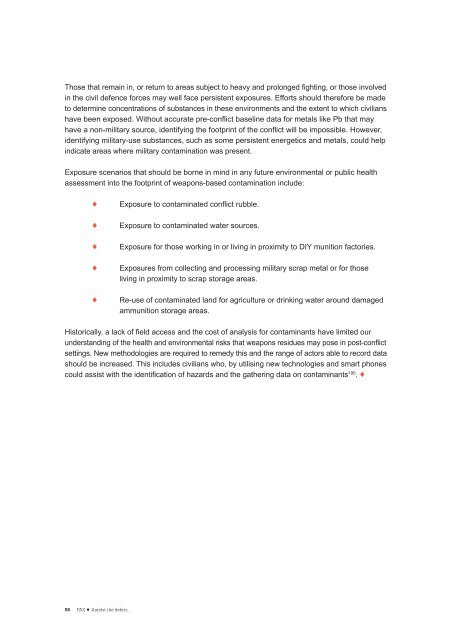Amidst the debris..
pax-report-amidst-the-debris-syria-web
pax-report-amidst-the-debris-syria-web
You also want an ePaper? Increase the reach of your titles
YUMPU automatically turns print PDFs into web optimized ePapers that Google loves.
Those that remain in, or return to areas subject to heavy and prolonged fighting, or those involved<br />
in <strong>the</strong> civil defence forces may well face persistent exposures. Efforts should <strong>the</strong>refore be made<br />
to determine concentrations of substances in <strong>the</strong>se environments and <strong>the</strong> extent to which civilians<br />
have been exposed. Without accurate pre-conflict baseline data for metals like Pb that may<br />
have a non-military source, identifying <strong>the</strong> footprint of <strong>the</strong> conflict will be impossible. However,<br />
identifying military-use substances, such as some persistent energetics and metals, could help<br />
indicate areas where military contamination was present.<br />
Exposure scenarios that should be borne in mind in any future environmental or public health<br />
assessment into <strong>the</strong> footprint of weapons-based contamination include:<br />
! Exposure to contaminated conflict rubble.<br />
! Exposure to contaminated water sources.<br />
! Exposure for those working in or living in proximity to DIY munition factories.<br />
! Exposures from collecting and processing military scrap metal or for those<br />
living in proximity to scrap storage areas.<br />
! Re-use of contaminated land for agriculture or drinking water around damaged<br />
ammunition storage areas.<br />
Historically, a lack of field access and <strong>the</strong> cost of analysis for contaminants have limited our<br />
understanding of <strong>the</strong> health and environmental risks that weapons residues may pose in post-conflict<br />
settings. New methodologies are required to remedy this and <strong>the</strong> range of actors able to record data<br />
should be increased. This includes civilians who, by utilising new technologies and smart phones<br />
could assist with <strong>the</strong> identification of hazards and <strong>the</strong> ga<strong>the</strong>ring data on contaminants 195 . !<br />
58 PAX ! <strong>Amidst</strong> <strong>the</strong> <strong>debris</strong>...


